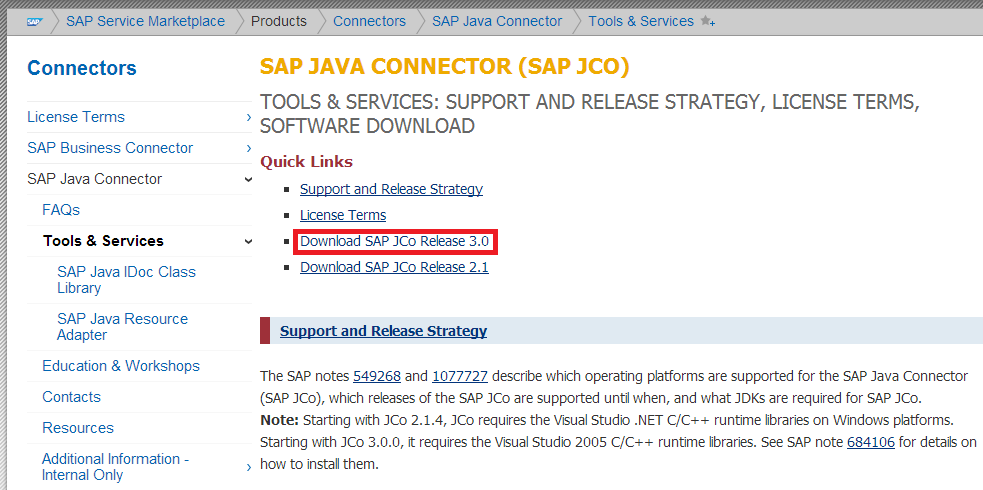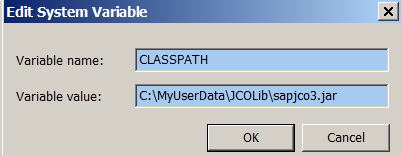
- SAP Community
- Products and Technology
- Technology
- Technology Blogs by SAP
- Step by step to download and configure JCO in your...
Technology Blogs by SAP
Learn how to extend and personalize SAP applications. Follow the SAP technology blog for insights into SAP BTP, ABAP, SAP Analytics Cloud, SAP HANA, and more.
Turn on suggestions
Auto-suggest helps you quickly narrow down your search results by suggesting possible matches as you type.
Showing results for
Advisor
Options
- Subscribe to RSS Feed
- Mark as New
- Mark as Read
- Bookmark
- Subscribe
- Printer Friendly Page
- Report Inappropriate Content
02-11-2014
9:00 AM
This blog can be used as a very simple tutorial for those guys who are new to JCO. It demonstrates how to download and configure the JCO in your laptop. A simple consumption from JAVA side to call a remote function module in ABAP side is done to verify the correctness of the configuration.
1. download SAP JCO3.0 from service marketplace

Choose the proper file according to your OS to download:

Unzip the downloaded file, create a new folder and put the dll and jar file into the folder.

add your local folder path to PATH environment variable:

maintain the absolute path for jar file as value for CLASSPATH:

Note: there is a folder javadoc after downloaded file is unzipped and it contains detailed information about JCO like installation guide, API documentation and sample code etc.
2. Create a new Java project. Right click on project and click "Property".

Add the JCO jar file to the project by clicking button "Add External JARs".

3. Create a simple remote function module in ABAP. The function module just accepts the product ID passed from JAVA side, and query against it in database table COMM_PRODUCT, and return the query result which will be fetched via JCO in JAVA side. Never forget to mark the "Remote enabled Function module" flag.

4. copy the attached JAVA source code to your project.
For demonstration purpose, the sample code just use a local file to store ABAP destination configuration which would lead to security issues and should not be used in productive code.
Just specify your own ABAP system information and your user credentials in the sample code:

in the test code, we hard code the product ID as ARNO_TEST004. Here below is the execution result, the detail information of this product is returned to JAVA side:

We can compare it with the information in SE16, and they are exactly the same:

1. download SAP JCO3.0 from service marketplace

Choose the proper file according to your OS to download:

Unzip the downloaded file, create a new folder and put the dll and jar file into the folder.

add your local folder path to PATH environment variable:

maintain the absolute path for jar file as value for CLASSPATH:

Note: there is a folder javadoc after downloaded file is unzipped and it contains detailed information about JCO like installation guide, API documentation and sample code etc.
2. Create a new Java project. Right click on project and click "Property".

Add the JCO jar file to the project by clicking button "Add External JARs".

3. Create a simple remote function module in ABAP. The function module just accepts the product ID passed from JAVA side, and query against it in database table COMM_PRODUCT, and return the query result which will be fetched via JCO in JAVA side. Never forget to mark the "Remote enabled Function module" flag.

4. copy the attached JAVA source code to your project.
For demonstration purpose, the sample code just use a local file to store ABAP destination configuration which would lead to security issues and should not be used in productive code.
Just specify your own ABAP system information and your user credentials in the sample code:

in the test code, we hard code the product ID as ARNO_TEST004. Here below is the execution result, the detail information of this product is returned to JAVA side:

We can compare it with the information in SE16, and they are exactly the same:

- SAP Managed Tags:
- ABAP Connectivity,
- ABAP Development,
- SAP NetWeaver
3 Comments
You must be a registered user to add a comment. If you've already registered, sign in. Otherwise, register and sign in.
Labels in this area
-
ABAP CDS Views - CDC (Change Data Capture)
2 -
AI
1 -
Analyze Workload Data
1 -
BTP
1 -
Business and IT Integration
2 -
Business application stu
1 -
Business Technology Platform
1 -
Business Trends
1,661 -
Business Trends
91 -
CAP
1 -
cf
1 -
Cloud Foundry
1 -
Confluent
1 -
Customer COE Basics and Fundamentals
1 -
Customer COE Latest and Greatest
3 -
Customer Data Browser app
1 -
Data Analysis Tool
1 -
data migration
1 -
data transfer
1 -
Datasphere
2 -
Event Information
1,400 -
Event Information
66 -
Expert
1 -
Expert Insights
178 -
Expert Insights
293 -
General
1 -
Google cloud
1 -
Google Next'24
1 -
Kafka
1 -
Life at SAP
784 -
Life at SAP
12 -
Migrate your Data App
1 -
MTA
1 -
Network Performance Analysis
1 -
NodeJS
1 -
PDF
1 -
POC
1 -
Product Updates
4,577 -
Product Updates
340 -
Replication Flow
1 -
RisewithSAP
1 -
SAP BTP
1 -
SAP BTP Cloud Foundry
1 -
SAP Cloud ALM
1 -
SAP Cloud Application Programming Model
1 -
SAP Datasphere
2 -
SAP S4HANA Cloud
1 -
SAP S4HANA Migration Cockpit
1 -
Technology Updates
6,886 -
Technology Updates
416 -
Workload Fluctuations
1
Related Content
- How to use AI services to translate Picklists in SAP SuccessFactors - An example in Technology Blogs by SAP
- ABAP Cloud Developer Trial 2022 Available Now in Technology Blogs by SAP
- SAP Enable Now setup in Technology Blogs by Members
- explore the business continuity recovery sap solutions on AWS DRS in Technology Blogs by Members
- Cloud Integration: Manually Sign / Verify XML payload based on XML Signature Standard in Technology Blogs by SAP
Top kudoed authors
| User | Count |
|---|---|
| 30 | |
| 23 | |
| 10 | |
| 7 | |
| 6 | |
| 6 | |
| 5 | |
| 5 | |
| 5 | |
| 4 |